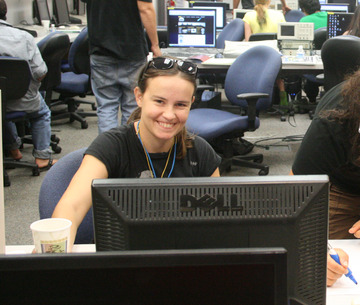
Jamie Scharf was born and raised in California. From a very young age, she has been interested in the other planets within our solar system, especially Mars. With the goal of becoming a planetary science researcher, she graduated from Porterville College in California in 2008 with an A.S. in Biological and Physical Science, before transferring to University of Hawaii at Hilo to pursue a triple major in Astronomy, Physics, and Geology. In her free time, she volunteers at the Mauna Kea Visitor Information Station, reads books on a wide variety of subjects, hikes, games, and stargazes. She is thrilled to have had the opportunity to work with Gemini this summer.
Home Island: Mainland
Institution when accepted: University of Hawaii at Hilo
Akamai Project: Shaking the Sky: Monitoring the Effects of Earthquakes on Telescopes
Project Site: Gemini Observatory
Mentor: Mike Sheehan
Earthquakes are significant in the astronomical community in that they can damage multi-million dollar telescopes, rendering them unable to be used for science until they are repaired. Installing accelerometers on the Gemini North telescope support structure, as well as a seismic accelerometer outside the observatory, would show how ground movement affects the telescope at any point in time. This project’s focus is to design a seismometer vault to be placed outside the Gemini telescope. This vault must meet particular specifications: unlike most other seismometer installations, we wish to observe “cultural noise” (ground motion caused by human activity) as well as earthquakes, in order to see what effect, if any, human activity has on the telescope. We have compiled several different designs based on composites of already existing seismometer vaults. The vault must be insulated against changes in both temperature and moisture, and must be stable enough so that traffic and shifting soil will not change the orientation of the seismometer; precise alignment is necessary for measuring the direction and force of ground waves. The vault will be connected to the observatory building by a conduit, and data from both the seismometer and the accelerometers will be routed to a central computer. This computer will be set to record data when triggered by a minimum threshold of movement by the seismic accelerometer. We will install the seismometer vault once we have permission from the Office of Mauna Kea Management, as approval is needed to excavate any hole within the boundaries of the Mauna Kea Science Reserve. In the meantime, we are constructing the bucket that will hold the seismic accelerometers and are running tests to see how the system is affected by noise.